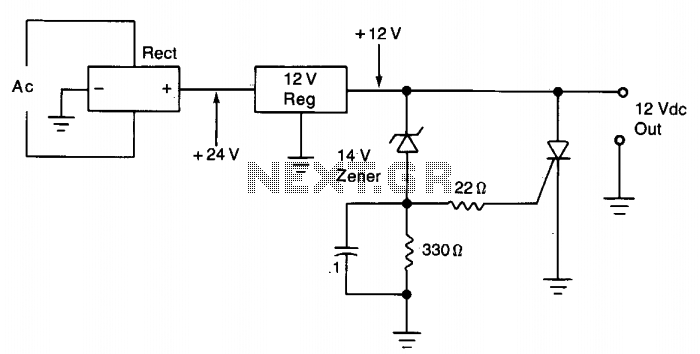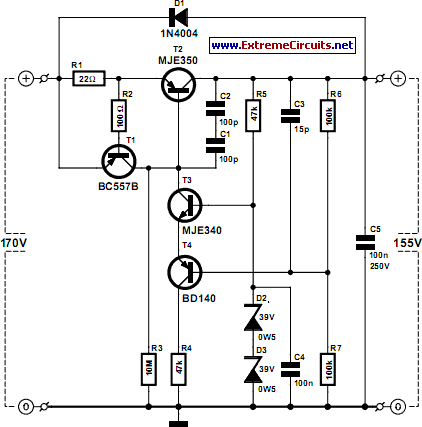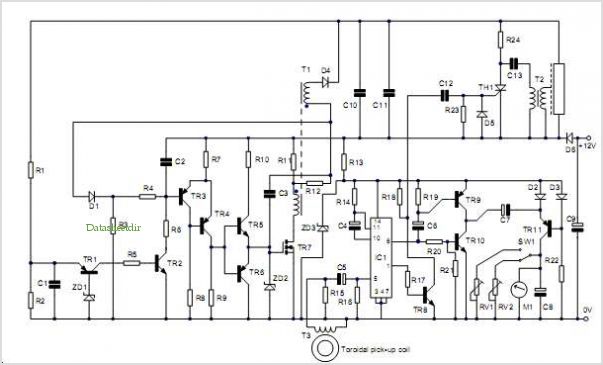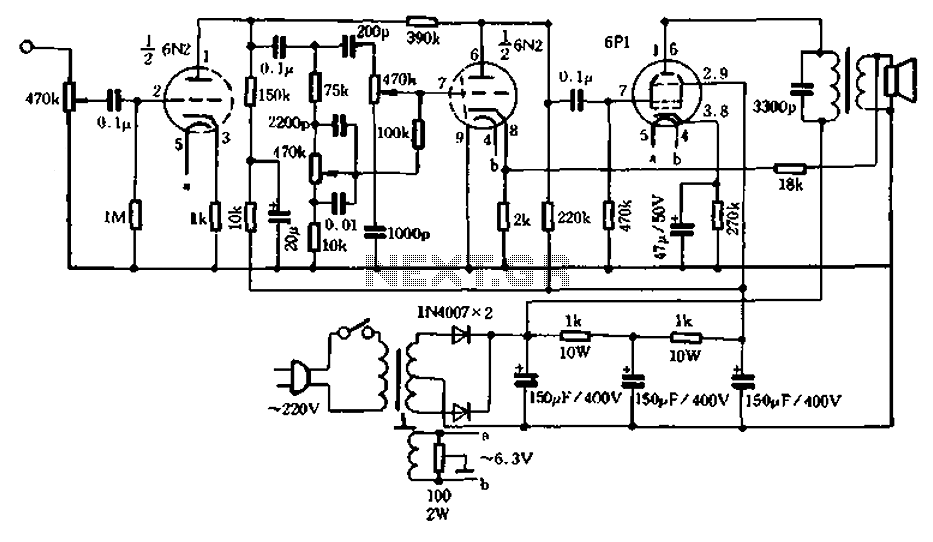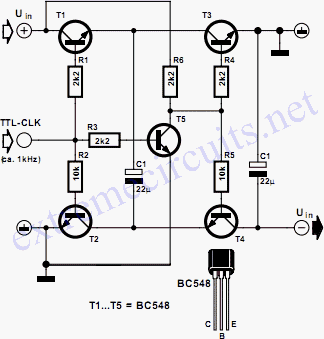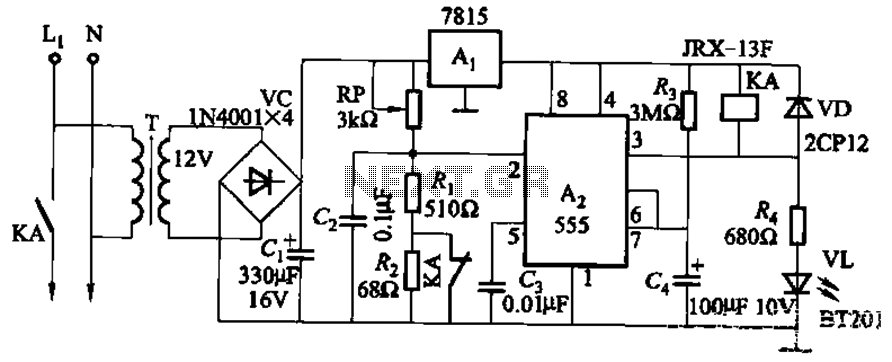
Low Voltage Preamplifier

This is a specialized low-voltage version of an audio preamplifier. The emitter voltage of transistor T1 is biased close to half the supply voltage (1.5V) to enable maximum output voltage swing. Both transistors are directly coupled and utilize closed-loop feedback to enhance temperature stability. Transistor T2 achieves the amplifier's full voltage gain, and for low noise operation, the collector current of T2 is approximately 70 µA. T1 functions as a buffer for T2 and operates in emitter follower mode, providing a low output impedance. The overall signal-to-noise (S/N) ratio measured at the output is detailed below. Capacitor C3 decouples the emitter resistor of T2; without C3, the gain of T2 would be approximately R1/R4. With C3, the gain of T2 is now determined by R4 in parallel with the input impedance of T1 and the small-signal emitter resistance of T2. The overall voltage gain of the circuit is around 28 times, as indicated below. Harmonic distortion is approximately 8%. One limitation of this circuit is that the input impedance is relatively low due to T2's low input and the presence of C3 decoupling the emitter. The inclusion of resistor R7 in series with the base of T2 slightly increases the input impedance. A plot of input impedance versus frequency response is provided below. The output impedance is very low, around 66 ohms, as shown in the plot below. It is important to note that this is a preamplifier designed to feed into a power amplifier and not intended to drive direct loads.
This audio preamplifier circuit is designed for low-voltage applications, emphasizing performance in terms of gain, noise, and impedance characteristics. The architecture employs two bipolar junction transistors (BJTs) configured for optimal audio signal amplification. The emitter of T1 is set to approximately half the supply voltage to maximize the output voltage swing, which is critical for audio fidelity.
The direct coupling between T1 and T2 allows for efficient signal transfer while maintaining stability through closed-loop feedback. This feedback mechanism is essential for mitigating variations in temperature that could otherwise impact performance. T2 is responsible for achieving the desired voltage gain, and its collector current is optimized at 70 µA to minimize noise, a crucial factor in audio applications.
T1 operates as an emitter follower, which not only buffers the signal from T2 but also contributes to a low output impedance, measured at approximately 66 ohms. This low output impedance is advantageous for driving subsequent stages, such as power amplifiers, ensuring that the preamp can effectively interface with various loads without significant signal degradation.
Capacitor C3 plays a vital role in the circuit by decoupling the emitter resistor of T2. This decoupling affects the gain characteristics; without C3, the gain would be limited to the ratio of resistors R1 to R4. However, with C3 in place, the gain is influenced by the parallel combination of R4 and the input impedance of T1, as well as the small-signal emitter resistance of T2, resulting in a total gain of approximately 28 times.
The audio quality is also assessed through harmonic distortion measurements, which are reported at around 8%. While this level of distortion is acceptable for many applications, it indicates that careful design considerations were made to balance gain and fidelity.
One of the circuit's limitations is its relatively low input impedance, which can be attributed to the characteristics of T2 and the decoupling action of C3. To address this, resistor R7 is introduced in series with the base of T2, providing a slight increase in input impedance, which can enhance compatibility with various audio sources.
Overall, this low-voltage audio preamplifier circuit exemplifies a thoughtful design that prioritizes gain, noise performance, and impedance matching, making it suitable for integration into larger audio systems. It is a crucial component in the signal chain, ensuring that audio signals are amplified effectively before being sent to power amplification stages.This is a special low voltage version of my audio preamp. T1`s emitter voltage is biased close to half supply voltage (1. 5V) to allow for maximum output voltage swing. Both transistors are direct coupled and have closed loop feedback to aid temperature stability. T2 realizes the amplifiers full voltage gain, and for low noise operation, T2 collect or current is about 70uA. T1 merely buffers T2 and operates in emitter follower mode providing a good low output impedance. The overall S/N ratio measured at the output is shown below: Capacitor C3 decouples the emitter resistor of T2. Without C3 the gain of T2 would be approximately R1 / R4. With C3 the gain of T2 is now R4 in parallel with the input impedance of T1 / the small signal emitter resistance of T2.
The overall voltage gain of the circuit is around 28 times as shown below. Harmonic distortion is about 8%. One drawback of this circuit is that the input impedance is fairly low. This is because the input of T2 is low and has C3 decoupling the emitter. The inclusion of R7 in series with the base of T2 raises input impedance slightly. A plot of input impedance versus freqency response is shown below. The output impedance is very low, around 66 ohms as shown in the plot below. Note that this is a preamp and therefore designed to feed into a power amplifier not drive direct loads directly. 🔗 External reference
This audio preamplifier circuit is designed for low-voltage applications, emphasizing performance in terms of gain, noise, and impedance characteristics. The architecture employs two bipolar junction transistors (BJTs) configured for optimal audio signal amplification. The emitter of T1 is set to approximately half the supply voltage to maximize the output voltage swing, which is critical for audio fidelity.
The direct coupling between T1 and T2 allows for efficient signal transfer while maintaining stability through closed-loop feedback. This feedback mechanism is essential for mitigating variations in temperature that could otherwise impact performance. T2 is responsible for achieving the desired voltage gain, and its collector current is optimized at 70 µA to minimize noise, a crucial factor in audio applications.
T1 operates as an emitter follower, which not only buffers the signal from T2 but also contributes to a low output impedance, measured at approximately 66 ohms. This low output impedance is advantageous for driving subsequent stages, such as power amplifiers, ensuring that the preamp can effectively interface with various loads without significant signal degradation.
Capacitor C3 plays a vital role in the circuit by decoupling the emitter resistor of T2. This decoupling affects the gain characteristics; without C3, the gain would be limited to the ratio of resistors R1 to R4. However, with C3 in place, the gain is influenced by the parallel combination of R4 and the input impedance of T1, as well as the small-signal emitter resistance of T2, resulting in a total gain of approximately 28 times.
The audio quality is also assessed through harmonic distortion measurements, which are reported at around 8%. While this level of distortion is acceptable for many applications, it indicates that careful design considerations were made to balance gain and fidelity.
One of the circuit's limitations is its relatively low input impedance, which can be attributed to the characteristics of T2 and the decoupling action of C3. To address this, resistor R7 is introduced in series with the base of T2, providing a slight increase in input impedance, which can enhance compatibility with various audio sources.
Overall, this low-voltage audio preamplifier circuit exemplifies a thoughtful design that prioritizes gain, noise performance, and impedance matching, making it suitable for integration into larger audio systems. It is a crucial component in the signal chain, ensuring that audio signals are amplified effectively before being sent to power amplification stages.This is a special low voltage version of my audio preamp. T1`s emitter voltage is biased close to half supply voltage (1. 5V) to allow for maximum output voltage swing. Both transistors are direct coupled and have closed loop feedback to aid temperature stability. T2 realizes the amplifiers full voltage gain, and for low noise operation, T2 collect or current is about 70uA. T1 merely buffers T2 and operates in emitter follower mode providing a good low output impedance. The overall S/N ratio measured at the output is shown below: Capacitor C3 decouples the emitter resistor of T2. Without C3 the gain of T2 would be approximately R1 / R4. With C3 the gain of T2 is now R4 in parallel with the input impedance of T1 / the small signal emitter resistance of T2.
The overall voltage gain of the circuit is around 28 times as shown below. Harmonic distortion is about 8%. One drawback of this circuit is that the input impedance is fairly low. This is because the input of T2 is low and has C3 decoupling the emitter. The inclusion of R7 in series with the base of T2 raises input impedance slightly. A plot of input impedance versus freqency response is shown below. The output impedance is very low, around 66 ohms as shown in the plot below. Note that this is a preamp and therefore designed to feed into a power amplifier not drive direct loads directly. 🔗 External reference
